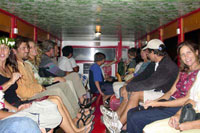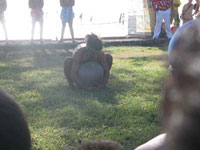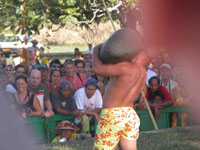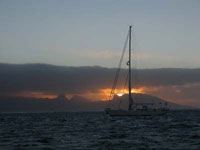| 2C Update #117
Tahiti & Heiva
July 2, 2004
The bulk of the cruising boats doing the South Pacific arrive in Tahiti between the middle of June and the middle of July, just in time for the annual Heiva celebration. This is a good thing, because, other than the bright spot of the Heiva festivities, Tahiti is a black hole for cruisers.
A black hole? This pearl of Polynesia -- Damn straight. And it's one that most all the boats get caught in for a matter of weeks. Probably the smartest thing to do would be to skip it entirely, except that after two to three months of hard cruising almost everybody has repairs to make, and this really is the best place to make them. Papeete , the biggest urban center in thousands of miles, does have lots of services, chandleries, riggers, sailmakers, and, when all else fails, a FedEx depot.
It also has some really nice supermarkets where reprovisioning can be managed without breaking the budget if you just pay attention. The ubiquitous baguette, at 40 cents a meter, covers breakfast (with jam) and lunch (with ham and cheese) and hors d'oeuvres (with paté and brie.) There are surprises like steak and lamb being better values than chicken, and vegies and salad-makings are gorgeous (who cares what they cost). Beer is expensive, even in the supermarkets at $2.40 a can, and while there is a whole double-sided aisle of French wine, you can also buy it by the very affordable 3-liter box.
So whats so bad about Tahiti - The list is not short. First off, it has most of the usual urban ills, plus a few peculiar to it. Cruising boats used to tie stern-to the long waterfront quay right downtown, and the municipal facilities there look modern and well-equipped. The quay gave cruisers ready access to town and the cheap eateries-on-wheels known as roulettes. But there have been more than twenty-five break-ins aboard boats that have used the quay this year, even boats with people aboard, with thousands of dollars of lost equipment. So most cruisers have opted either for anchoring off Maeva Beach where the water is deep (40-55') and the fetch in southerly blows too long or for the very expensive Marina Taina. Several boats dragged in Maeva this season in days of 40-50 knot southerlies wreaking damage on themselves and other boats. But even inside Marina Taina is no guarantee of protection. Friends alongside the dock for repairs found their space a nightmare when the wind went south and the floating dock turned into a wild creature. The vagaries of nature aside, the attentions of marina personnel was, generally speaking, disinterested. This at a $1/ft per day!
 |
 |
Next there is the pollution: noise and air. Papeete and its suburban area have lots of traffic (which fortunately for the cruisers includes a decent bus and "LeTruck" service), which roars by at breakneck speeds. Should you wish to cross a street, you'd better be sure your feet are in the designated crosswalk, because this magically stops the flow. Jaywalking, however, is suicidal. Along with exhaust from combustion engines, the fragrance of the flowers has to compete with smoke from omnipresent trash fires. To be fair, I think most of these fires burn to keep up with the debris generated by all the coconut palms, but it gave plenty of cruisers respiratory problems. I'm not even going to touch on the French commitment to cigarettes.
 |
 |
While food shopping is reasonably affordable (especially considering we are on an island in the middle of the ocean), the restaurants are not. That's NOT, in capital letters. There is no place for cruisers to hang out and meet each other, let alone the locals because even the simplest café meal will add up to $30-40 per couple while a real restaurant can't be escaped for less than $50-70. The solution to eating out is eating on your feet. As long as you are willing to eating something on a baguette -- and something on a baguette could be hamburger and fries or chow mein (yes, inside the baguette), then you won't starve. But if you want a table and chair, you will pay. So you'd better plan your day carefully because if you don't get downtown EARLY, you will find all the stores closing around you at 11:30 and no refuge until they reopen 1½ to 2 hours later. And don't be thinking you will be able to afford something to wash that baguette down. Beverages are in the $3-6 range. Believe me, this makes the McDonald's arches a welcome sight.
One truly wonders where the cash comes from to keep the whole ball rolling. Can the locals possibly afford all this? Are there enough tourists who will? And why would they? In Papeete we saw almost no evidence of the famed Polynesian hospitality. I can't even see that they have a grasp of good business strategy. Marina Taina, in position to make a killing providing service to all those yachts anchored off their facility, made no effort to be welcoming - and that's even to people paying them for dockage!
The only light on this bleak horizon were the festivities associated with the annual Heiva celebration. Traditionally linked to France 's celebration of Independence Bastille Day on July 14 --, this year's festival reflected the recent political success of French Polynesia 's pro-independence party. The new government moved the date of French Polynesia 's autonomy day from June to July 12 and then shift the traditional parade and fireworks to that day. Bastille Day itself was dead quiet! There were a lot of French tourists who looked adrift.
However, political statements aside, the festival is about Polynesian culture -- dance, music, and traditional athletics, and we were able to absorb a big dose of all. We went to the second of six nights of dance and choral competition at the lovely outdoor cultural center on the waterfront.. Each 3½-hour evening saw two dance presentations with an a capella choral group sandwiched between. The dances were large-scale story "ballets" (for want of a better word) complete with a huge corps of male and female dancers, soloists, and an "orchestra" of traditional drums, percussion instruments, flutes and ukeleles. Here at last, Don had his beautiful young dancing maidens, and there were plenty of virile young bare-chested guys for me to enjoy too. The dance is sexually charged and incredibly energetic, and the costumes complex and revealing at the same time. Unfortunately, no effort was made to translate the story narration at the start into English, and the French was so quick and colloquial I didn't have a chance, so we were largely ignorant of the storylines, which is a shame. I'm sure it could only have added to the experience.
Throughout the week there were "pirogue" races, the "pirogues" being one-man, three-man, six-man and sixteen-man (or woman) outrigger canoes. One all-day race started in Papeete , rounded "nearby" Moorea and retuned back to the waterfront. (Moorea is twelve miles away from Tahiti !) We went out in our dinghy to photograph the 16-"man" races and could barely keep up with the ladies with our 15hp outboard!
Then one Sunday we bussed to a venue in the town of Pae'a to watch the javelin-throwing and stone-lifting competitions. Here we found a couple of dozen guys, bare-chested and in team pareus with flower garlands in their hair throwing sticks with murderous points at a coconut suspended 30 feet in the air and some 60 feet away! This actually was pretty cool, and very atmospheric. The stone-lifting competition was pretty ponderous, literally and figurative. The spectators crowded around a rectangle of grass where the competitors faced off one on one against "the stone," a chiseled cylinder weighing 100 kilos (and only somewhat smaller for the younger lightweights). We'd anticipated sumo-type guys, especially as the islands do seem to have them, but most of the competitors were of fairly average build. The object was to grasp this stone and hoist it to your shoulder as quickly as possible. None of the lightweights succeeded, but all but one or two of the older group did - eventually. Pretty exciting stuff - sponsored by the Hernia Repair Center of Tahiti, no doubt.
Finally on July 12 the autonomy day commemoration we watched a parade downtown in the morning, mostly of various community groups marching in matching flowered outfits. No marching bands. (Eventually we ducked out to McDonalds!) We gave autonomy day another shot that evening, on hand for feu d'artifice (fireworks) over the harbor. It's my long-held motto that if someone is going to send that money up in smoke, its my moral obligation not to miss it. In fact, it was a pretty great show attended by lots of families as well as tourists. The fireworks were followed by a "concert", yet another dance performance by, of all things, a group from California, presenting dances from all the different islands of Polynesia. The dances were all quite different from one another, but without an announcer, we had no idea which islands they were from. So, we were stunned when this was followed by an American-style rock group, singing old rock standards in English! Now we get English?!?!? After the bright Polynesian music it sounded heavy and plodding, like a bunch of middle-aged rockers who can't let the old days go. The crowd (even the Western tourists) sat watching without moving a muscle, a phenomenon we attributed to the fact that nobody was drinking. We slithered home in something close to embarrassment.
 |
 |
In sum, we conclude that if you are a cruiser and must pass through Papeete, try to do so in time to take advantage of Heiva. But, if you are a regular tourist looking to spend hard-earned dollars on the vacation of your dreams - go anywhere but here.

|